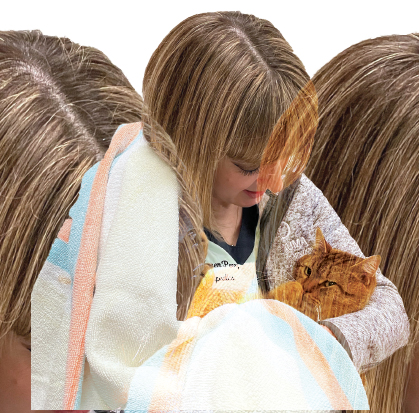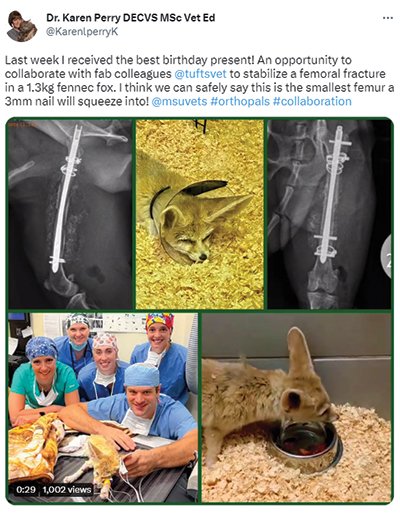

Dr. Karen Perry, MSU College of Veterinary Medicine associate professor and orthopedic surgeon, has been named the Pat Carrigan Chair in Feline Medicine.

Perry earned her veterinary degree at the University of Edinburgh in Scotland, where she later underwent a small animal surgery residency. Early in her career, she worked in mixed animal practice and completed an internship in small animal orthopedics and neurosurgery. She is a diplomate of the European College of Veterinary Surgeons and a fellow of the Higher Education Academy. Perry served as a lecturer in small animal orthopedics at the Royal Veterinary College, London, and she obtained a master’s degree in veterinary education from the University of London in 2019.
“Cats have always been a huge part of my life,” she says. “Looking at old family photos, it’s rare to find one where I don’t have a cat in my arms. My fascination with them has only expanded during my professional career to date. Receiving this endowed professorship feels like a life-long interest is coming to fruition; it’s incredibly rewarding.”
The endowment will allow Perry to expand research and treatment modalities that focus on pressing issues affecting feline health.
“I’m honored and thankful to the incredible individuals who inspired me in vet school and to colleagues who continue to inspire me to make a difference in feline orthopedics,” says Perry. “Being given the opportunity to take my ideas further is huge. I’m incredibly honored.”
“Dr. Perry is an excellent orthopedic surgeon and compassionate clinician who is well-respected by faculty, students, and clients for the quality of her patient care and communications, innovation in clinical practice, and her highly effective clinical and classroom instruction,” says Dr. Birgit Puschner, former dean of the College. “We are excited for the ways she will advance feline health through this professorship.”
LeMon’s studying the impacts of early-life adversity (ELA) and how it affects chronic inflammatory disease later in life. Her ultimate goal is to identify a target for which to develop a drug that would lessen or negate ELA’s impact on these diseases—asthma, heart disease, depression, and others—across the lifespan.
“We’re focusing on the mast cell because it’s a critical driver of immunity, robustly activated by stress, and programmed during early life,” says LeMon.
When Perry joined the College in 2015, it was with a particular purpose: to enhance the feline-specific expertise in the Veterinary Medical Center’s Orthopedic Surgery Service. She aimed to hone her surgery skills and expand into areas of research beyond her established clinical research focus.
“A major goal is to improve orthopedic care for cats; they’ve been an underserved population in orthopedics for a long time,” she says. “And though things are progressing, there’s so much room to grow. In addition to investigating novel procedures and therapeutics, we also aim to educate owners and primary care vets on feline conditions so that diagnoses can be made earlier, which can lead to a more favorable prognosis.”
In 2021, an initiative—which Perry led—was launched by AO Vet North America: the country’s first-ever master’s course in feline orthopedics. Perry co-chairs the program with Dr. Sharon Kerwin of the University of Texas A&M School of Veterinary Medicine and Biomedical Sciences. After a successful first run, the course will be offered again in 2024.
Perry also has been instrumental in growing the College’s reputation near and far, in part due to her efforts to publicize data in the field of orthopedics. She’s used traditional avenues and social media to educate veterinary professionals on new and existing surgical techniques.
“We’re increasing the number of cats seen in the Orthopedic Service here,” she says. “We’re becoming known as a place to get advice about cats. People have reached out from as far afield as New Zealand and Saudi Arabia for advice about how to manage feline-specific conditions.”
The classroom is another vital stage for improving feline orthopedic knowledge.
Dr. Karen Perry avidly shares interesting case studies on social media. Follow along at #OrthoPals on Twitter.

Passing on what we learn to the next generation of veterinarians is critically important,” she says. “We specifically teach our students about feline osteoarthritis, for example. Making time for feline-specific information within our curriculum ensures that when students take their first steps in primary care practice, they can serve cats well from day one.”
Perry’s research has centered on traumatology, feline orthopedics, correction of limb deformities associated with patellar luxation, and the use of negative pressure wound therapy to minimize wound-associated complications. She has also published on common feline orthopedic conditions such as hip dysplasia and cranial cruciate ligament rupture, including describing their treatment.
In her role as the Pat Carrigan Chair, Perry plans to explore the root causes of feline osteoarthritis.
“Osteoarthritis in cats is a huge problem,” she says. “It affects up to 90 percent of cats over the age of 12. The feline population is an aging one, and with cats living longer and longer, we routinely see cats suffer with arthritis-associated pain for 10 or more years. It’s important to develop our understanding of the condition if we are going to be more successful with therapeutics.”
Perry intends to investigate the mechanisms of osteoarthritis and establish different endotypes to allow veterinarians to be more targeted in their treatments.
“It is often stated that most cats develop primary osteoarthritis, which means that we have not established an underlying cause. Without knowing the cause of the condition, we are limited to treatment aimed to ameliorate clinical signs instead of being able to address the disease mechanism.”
